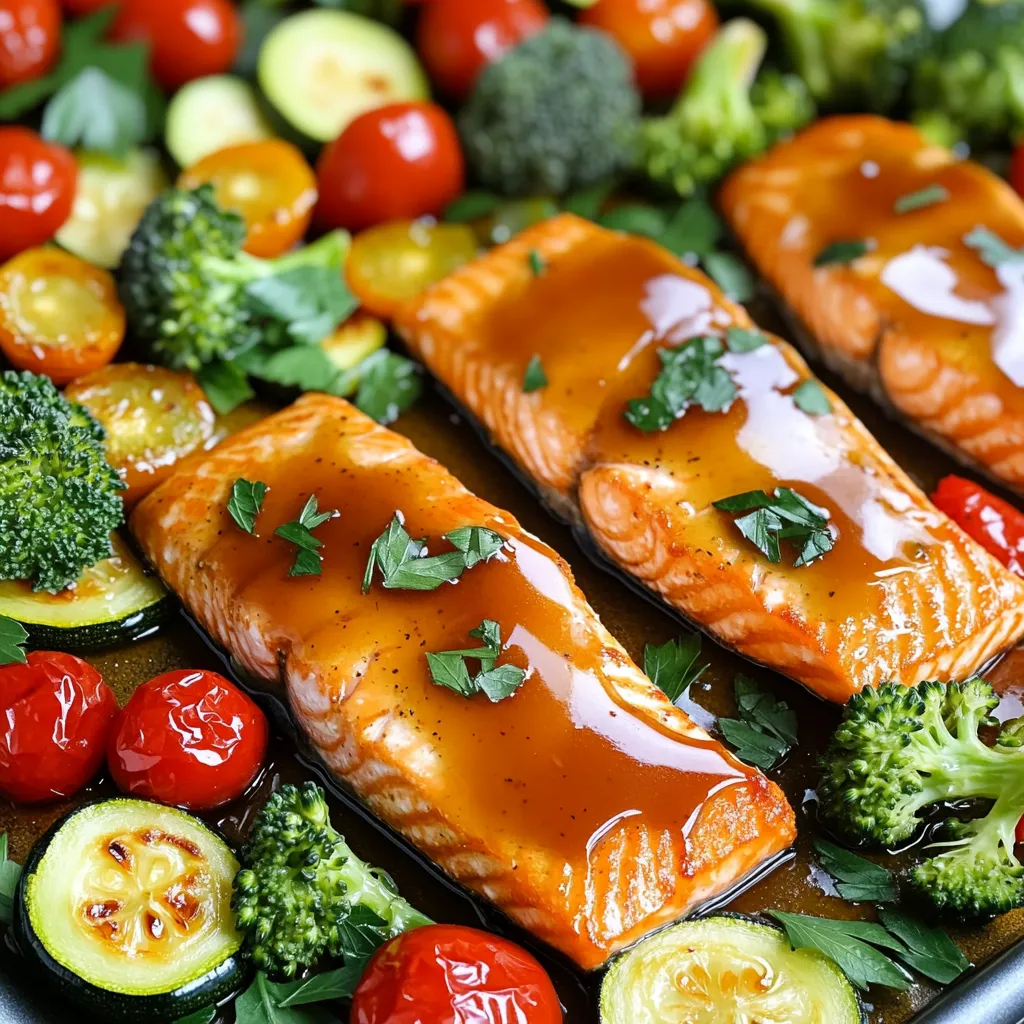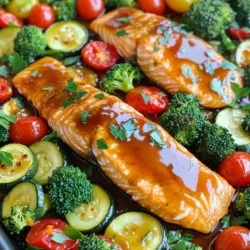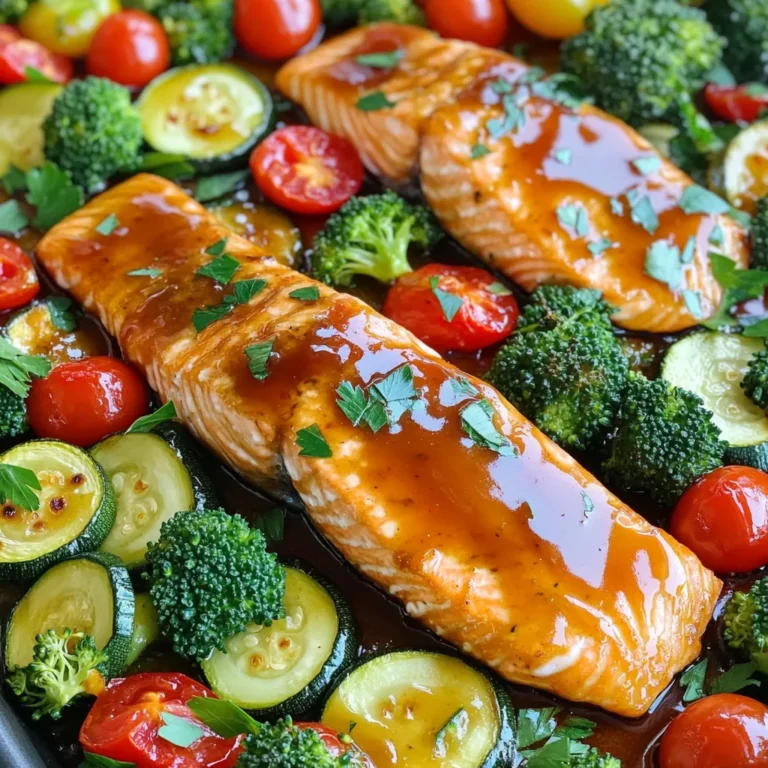Looking for a quick and tasty dinner? You’ll love this Sheet Pan Maple Dijon Salmon with Veggies! It’s simple, healthy, and perfect for busy nights. With just one pan, you can cook salmon and colorful veggies all at once. I’ll show you how to make it step-by-step so you can impress your family without stress. Let’s dive into this easy meal that’s full of flavor and joy!
Ingredients
Detailed List of Ingredients
To make Sheet Pan Maple Dijon Salmon Veggies, gather these simple ingredients:
– 4 salmon fillets
– 2 tablespoons pure maple syrup
– 2 tablespoons Dijon mustard
– 1 tablespoon olive oil
– 1 teaspoon garlic powder
– 1 teaspoon salt
– ½ teaspoon black pepper
– 1 red bell pepper, sliced
– 1 zucchini, sliced
– 1 cup cherry tomatoes, halved
– 1 cup broccoli florets
– Fresh parsley for garnish (optional)
These ingredients come together for a tasty meal. The salmon brings rich flavor, while the veggies add color and nutrition.
Equipment Needed
You will need some basic kitchen tools:
– Large sheet pan
– Parchment paper
– Small bowl
– Whisk
– Large mixing bowl
– Knife and cutting board
Having these tools ready will make cooking easy and fun.
Substitutions for Ingredients
If you can’t find certain ingredients, here are some great swaps:
– Salmon fillets: Use any firm fish like trout or cod.
– Maple syrup: Honey or agave syrup works as a sweetener.
– Dijon mustard: Yellow mustard or whole grain mustard are good options.
– Olive oil: Any cooking oil like canola or avocado oil is fine.
– Vegetables: Feel free to use asparagus, carrots, or bell peppers.
These substitutions keep your meal tasty while using what you have on hand.
Step-by-Step Instructions
Preparation Steps
1. First, preheat your oven to 400°F (200°C). This step is key for even cooking.
2. In a small bowl, whisk together:
– 2 tablespoons pure maple syrup
– 2 tablespoons Dijon mustard
– 1 tablespoon olive oil
– 1 teaspoon garlic powder
– 1 teaspoon salt
– ½ teaspoon black pepper
Mix until fully combined.
3. Next, take your salmon fillets and place them on a large sheet pan lined with parchment paper.
4. Use a brush to coat the salmon with the maple Dijon mix. Make sure to cover the tops and sides well.
5. In a separate bowl, combine:
– 1 sliced red bell pepper
– 1 sliced zucchini
– 1 cup halved cherry tomatoes
– 1 cup broccoli florets
Drizzle with olive oil and season with salt and pepper. Toss to coat.
Cooking Instructions
6. Arrange the seasoned veggies around the salmon on the sheet pan.
7. Bake in your preheated oven for 15-20 minutes. The salmon is done when it reaches an internal temperature of 145°F. The veggies should be tender with a slight caramelization.
8. Once finished, take the pan out of the oven and let it sit for a few minutes.
9. If you like, garnish with fresh parsley before serving.
Tips for Checking Doneness
To check if your salmon is done, use a food thermometer. Insert it into the thickest part of the fillet. It should read 145°F. If you don’t have a thermometer, look for the salmon to flake easily with a fork. The veggies should feel tender yet crisp. Enjoy your meal!
Tips & Tricks
How to Perfectly Cook Salmon
To cook salmon just right, pay attention to time and temperature. Preheat your oven to 400°F (200°C). Bake the salmon for 15 to 20 minutes. Check the salmon’s center; it should be opaque and flake easily with a fork. The internal temperature should reach 145°F. This ensures it is safe to eat and very tasty.
Enhancing Flavors with Seasonings
The maple Dijon mix is key to great flavor. It combines sweet maple syrup with tangy Dijon mustard. This blend gives the salmon a rich taste. Add garlic powder for depth. Always season your veggies, too! A bit of salt and pepper can bring out their natural sweetness. Feel free to swap in other herbs or spices that you enjoy.
Common Mistakes to Avoid
One common mistake is overcooking the salmon. Keep an eye on the time to prevent dryness. Another mistake is not coating the salmon well. Make sure each fillet gets a nice layer of the maple Dijon mix. When preparing veggies, cut them evenly for even cooking. Lastly, avoid crowding the sheet pan; this helps everything cook evenly.

Variations
Different Types of Fish
You can switch out salmon for other fish. Cod, trout, or tilapia work great. Each fish offers its own flavor. Cod has a mild taste, while trout brings a rich flavor. Cooking time may vary slightly. Always check for doneness. The fish should reach 145°F internally.
Alternative Vegetables
Feel free to change up the veggies too! Asparagus, carrots, or green beans are tasty options. Each vegetable brings its own crunch and color. You can even use sweet potatoes for a hearty touch. Just make sure to cut them into small pieces for even cooking.
Dietary Modifications
This recipe can fit many diets. For gluten-free, ensure your Dijon mustard is safe. You can also skip the maple syrup for a low-carb version. Use lemon juice for a zesty kick. This way, you keep the meal fresh and flavorful without extra carbs.
Storage Info
How to Store Leftovers
To store leftovers, let the dish cool first. Place the salmon and veggies in an airtight container. Keep it in the fridge. This helps maintain freshness. You can store it for up to three days. If you want to avoid soggy veggies, store them separately from the salmon.
Reheating Instructions
When reheating, use the oven for the best results. Preheat the oven to 350°F (175°C). Place the salmon and veggies on a baking sheet. Cover them with foil to lock in moisture. Heat for about 10-15 minutes. This method keeps the salmon moist and the veggies tender.
Freezing Tips
If you want to freeze leftovers, do so right away. Place the salmon and veggies in a freezer-safe bag. Squeeze out the air before sealing. You can freeze them for up to three months. To reheat, thaw overnight in the fridge. Then, follow the reheating instructions above.
FAQs
How long does it take to cook salmon on a sheet pan?
It takes about 15 to 20 minutes to cook salmon on a sheet pan. The oven should be set to 400°F (200°C). You want to check the salmon’s inside temperature. It should reach 145°F (63°C) when done. The salmon will be flaky and tender when it is fully cooked.
Can I use frozen salmon for this recipe?
Yes, you can use frozen salmon for this recipe. Just make sure to thaw it first. Thaw the salmon in the fridge overnight for best results. If you’re short on time, you can use the microwave. After thawing, follow the same steps as with fresh salmon. The cooking time may be slightly longer, so keep an eye on it.
What vegetable combinations work well with salmon?
Many vegetables pair nicely with salmon. Here are some great options:
– Asparagus
– Carrots
– Green beans
– Bell peppers
– Broccoli
– Zucchini
– Cherry tomatoes
These veggies add color and flavor. They also cook well in the oven alongside the salmon. Mix and match for your favorite combinations!
This post covered how to cook salmon perfectly. We explored ingredients, needed equipment, and great substitutes. I shared step-by-step cooking instructions and tips for checking doneness. You learned how to enhance flavors and avoid common mistakes. We also discussed various fish types, vegetables, and dietary options. Finally, I shared storage and reheating tips.
Cooking salmon is fun and easy. With these steps, you can enjoy great meals at home. Happy cooking!


